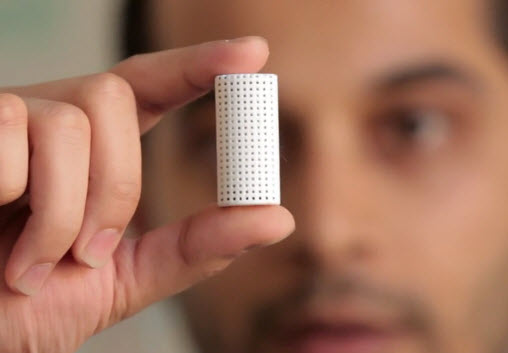How to turn carbon dioxide into sustainable concrete
March 15, 2016
A UCLA research team has developed a plan for capturing carbon from power-plant smokestacks (the largest source of harmful global greenhouse gas in the world) and use it to create a new building material — CO2NCRETE — that would be fabricated using 3D printers while replacing production of cement (which creates about 5 percent of the planet’s greenhouse gas emissions).
“I decided to get involved in this project because it could be a game-changer for climate policy,” said J.R. DeShazo, professor of public policy at the UCLA Luskin School of Public Affairs and director of the UCLA Luskin Center for Innovation. “This technology tackles global climate change, which is one of the biggest challenges that society faces now and will face over the next century.”
UCLA Luskin School of Public Affairs | Carbon upcycling: Turning carbon dioxide into CO2NCRETE
DeShazo has provided the public policy and economic guidance for this research. The scientific contributions have been led by Gaurav Sant, associate professor and Henry Samueli Fellow in Civil and Environmental Engineering; Richard Kaner, distinguished professor in chemistry and biochemistry, and materials science and engineering; Laurent Pilon, professor in mechanical and aerospace engineering and bioengineering; and Matthieu Bauchy, assistant professor in civil and environmental engineering.
Beyond just capturing CO2
This isn’t the first attempt to capture carbon emissions from power plants. It’s been done before, but the challenge has been what to do with the carbon dioxide once it’s captured.
The researchers are excited about the possibility of reducing greenhouse gas in the U.S., especially in regions where coal-fired power plants are abundant. “But even more so is the promise to reduce the emissions in China and India,” DeShazo said. “China is currently the largest greenhouse gas producer in the world, and India will soon be number two, surpassing us.”
Thus far, the new construction material has been produced only at a lab scale, using 3-D printers to shape it into tiny cones. “We have proof of concept that we can do this,” DeShazo said. “But we need to begin the process of increasing the volume of material and then think about how to pilot it commercially.
“This technology could change the economic incentives associated with these power plants in their operations and turn the smokestack flue gas into a resource countries can use, to build up their cities, extend their road systems,” DeShazo said. “It takes what was a problem and turns it into a benefit in products and services that are going to be very much needed and valued in places like India and China.”
Abstract of Direct Carbonation of Ca(OH)2 Using Liquid and Supercritical CO2: Implications for Carbon-Neutral Cementation
By invoking analogies to lime mortars of times past, this study examines the carbonation of portlandite (Ca(OH)2) by carbon dioxide (CO2) in the liquid and supercritical states as a potential route toward CO2-neutral cementation. Portlandite carbonation is noted to be rapid; e.g., >80% carbonation of Ca(OH)2 is achieved in 2 h upon contact with liquid CO2 at ambient temperatures, and it is only slightly sensitive to the effects of temperature, pressure, and the state of CO2 over the range of 6 MPa ≤ p ≤ 10 MPa and 8 °C ≤ T ≤ 42 °C. Additional studies suggest that the carbonation of anhydrous ordinary portland cement is slower and far less reliable than that of portlandite. Although cementation is not directly assessed, detailed scanning electron microscopy (SEM) examinations of carbonated microstructures indicate that the carbonation products formed encircle and embed sand grains similar to that observed in lime mortars. The outcomes suggest innovative directions for “carbon-neutral cementation.”
